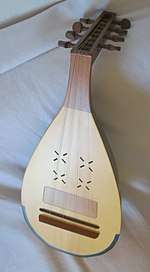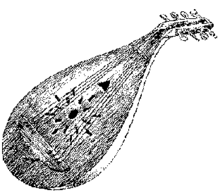Cobza
The cobza (also cobsa, cobuz, koboz) is a multi-stringed instrument of the lute family of folk origin popular in Romanian and Moldovan folklore (it is considered the oldest accompaniment instrument in the region). It is also used in the Hungarian Táncház movement (end of the 20th Century).
 | |
| String instrument | |
|---|---|
| Other names | Koboz |
| Classification |
|
| Hornbostel–Sachs classification | 321.321-6 (Composite chordophone sounded with a plectrum) |
| Related instruments | |
It is distinct from the Ukrainian Kobza, an instrument of a different construction and origin.[1]
Overview

The Romanian Cobza is metal-strung (although modern nylon-strung models exist, mostly in Hungary), and has a very short neck without frets (although a newer fretted cobza can be found in the Republic of Moldavia),[2] with a bent-back pegbox. The back is ribbed. It is usually double or triple strung, and often has a characteristic flat end clasp.

The Cobza is played with a plectrum (traditionally, a goose feather) in elaborate and florid melodic passagework, and has a pick-guard similar to that of an oud. Its strings are widely spaced at the bridge to facilitate this technique. It has a soft tone, most often tuned to D-A-D-G (although tuning depends per style, region and player).[3]
The origins of the Romanian Cobza are thought to be a local adaptation of the Persian barbat or Turkish oud, probably brought to the area by itinerant Romanimusicians in the 15th century[4] (a Rom/Romani musician is called lăutar, literally lute-player). A Cobza player specifically is called a "cobzar".[5] Notable Cobza players were Ion Păturică, Ion Zlotea, Marin Cotoanță, Grigore Kiazim (from Wallachia), Nicolae Păsnicuțu and Constantin Negel (from Moldavia).
It is said that the Cobza was also played in the 19th Century by Jewish musicians from Moldova region.[6] It seems that Cobza was also used in various music ensembles in the Bukovyna region in the mid war periods, being replaced totally by the mandolin and 4 stringed domra when this area became incorporated into the Ukrainian SSR.[7]
The name of the instrument may come from the Turkic "kopuz".[8]
References
- Gregory F. Barz, Timothy J. Cooley (eds.) (1997), Shadows in the Field: New Perspectives for Fieldwork in Ethnomusicology, Oxford University Press, New York, p. 187
- "Cobza - Patrimoniul cultural imaterial al Republicii Moldova". www.patrimoniuimaterial.md.
- "Moldvai csángó népzene és régi zene -". www.koboz.hu.
- "The Romanian Cobza". Campin.me.uk. 2016-01-08. Retrieved 2018-04-20.
- Viorel Cosma (1960), Figuri de Lautari, Musical Printing House, Bucharest, p. 230
- "Jewish Musicians in Moldavia". www.dinayekapelye.com.
- Mizynec, V. - Folk Instruments of Ukraine. Bayda Books, Melbourne, Australia, 1987 - 48с.
- "The Stringed Instrument Database: Index". stringedinstrumentdatabase.aornis.com.
External links
| Wikimedia Commons has media related to Cobza. |
- Cobza solo - Marin Cotoanță
- Countryside built Cobza recording
- "Datina" folk ensemble from Botoșani
- Robert Garfias - field recordings made in Romania during 1977
- A Romanian Cobza in Museum Collections
- Romanian Cobza in Museum Collections
- Romanian Cobza from Horniman Museum - on the left
- http://www.koboziskola.hu/